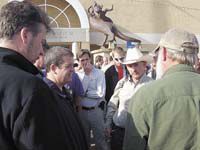| A crowd gathers in front of the College of Eastern Utah Prehistoric Museum for a tour of Range Creek. The museum served as the centerpiece of a media blitz when Range Creek became a topic of worldwide interest two years ago. Interviews and news reports were broadcast to locations throughout the world and the museum in Price became internationally known as the backdrop in the Range Creek issue. With the proposed creation of the Price Cretaceous Garden currently in the works, the museum’s celebrity could become more permanent. |
The idea of developing a local cretaceous garden accompanying what is growing to be a world-class prehistoric museum could be a travel draw tourists cannot resist.
Sinan Oguan, the managing director of Global Studies Institute, would like to see the local area take on the project.
GSI was formed as a non-profit educational organization in 1987 and the creation of it stemmed from the conception that students needed experiential learning as much or more than textbooks.
The organization is headquartered in Queensland, Australia, at a location inside the shoreline facing the Great Barrier Reef and in the Ancient Gondwanan Rainforest. The founders of GSI decided to place the headquarters at the location because of the site’s natural beauty and the fact that the area has great ecological significance when it comes to field studies and research.
But the founders have also sought out other places in the world where unique settings and circumstances exist.
Eastern Utah and Carbon County have a rich Cretaceous period history, uncovered shorelines and geology.
In addition, according to Oguan, the area has the perfect soil to grow the closest thing to a complete Cretaceous garden of anywhere in the world.
The cretaceous plant project is still in the talking stages, but so far many county agencies and the College of Eastern Utah are interested in being involved.
| An artists’s conceptual sketch of what a cretaceous garden could look like. Though some question whether such a project is economically viable, others believe that the project would bring added tourist value to the Castle Valley. |
The proposed facility would house about 600 species of plants, with a direct lineage to the plants of a time more than 64 million years ago. It would be the only garden of its kind in the world.
Tie that in with the idea of building a new College of Eastern Utah Prehistoric Museum on the bluffs southwest of Price where the facility could be easily seen from U.S. Highway 6 and the area could also have the makings of a world class tourist attraction.
But the conservatory could be much more than just a place where families travel to take in what it might have been like during the last portion of the age of dinosaurs.
The complex and its supporting facilities could become a classic place to study ancient times and could also become the breeding ground for plants of all kinds that could be exported around the world.
While the originals would come from other places as tissue cultures and not as whole plants, as the organisms were grown and put in one place, the local area could become the source for many of the unique forms of flora through micropropagation.
The tissue cultures that the growing labs here could produce could generate over $100,000 per year, according to officials from GSI.
Some, have questioned whether the draw would match the hype that is being put out about this project, but the proof could lie in an area similar to Price that exists about a thousand miles north of Utah.
The eastern Utah area has often been compared to Drumheller, Alberta, Canada, both in terms of size, geography and location in relation to large metropolitan areas. Drumheller has a world renowned prehistoric museum in the form of the Royal Tyrrell Museum, is in the middle of the Canadian badlands and is about 100 miles northeast of Calgary, a metropolitan area about the size of Salt Lake. According to information that the Drumheller economic officials have published, due to its unique Badlands topography, the Drumheller Valley has always held an appeal for tourists. Recognizing this potential, the Government of Alberta established the Royal Tyrrell Museum and since its opening in October of 1985, tourist traffic to Drumheller has increased from 100,000 visitors per year to over 400,000 per year. According to Alberta Tourism, the Drumheller Valley has now become the third most popular tourist destination in Alberta.
While GSI says that the gardens in Price would be a good idea, the money to build such a facility is another question that is being faced by local officials. Moves towards different kinds of funding are being explored, including CEU requesting funds from the legislature or from the Community Impact Board. GSI has proposed that it would help write a curriculum for field studies for CEU and would also bring in a botanist to help the college in growing the plants and training college and museum staff on their care. GSI says that the cost to put something like the gardens together would be around $2.7 million, but that the economic impact to the community could be in the area of $30 million per year.
Some preliminary drawings concerning the structure that would house the gardens have already been shown to various groups around the community, and most in the area seem very interested in both the education and economic value this could possibly provide Carbon County.

